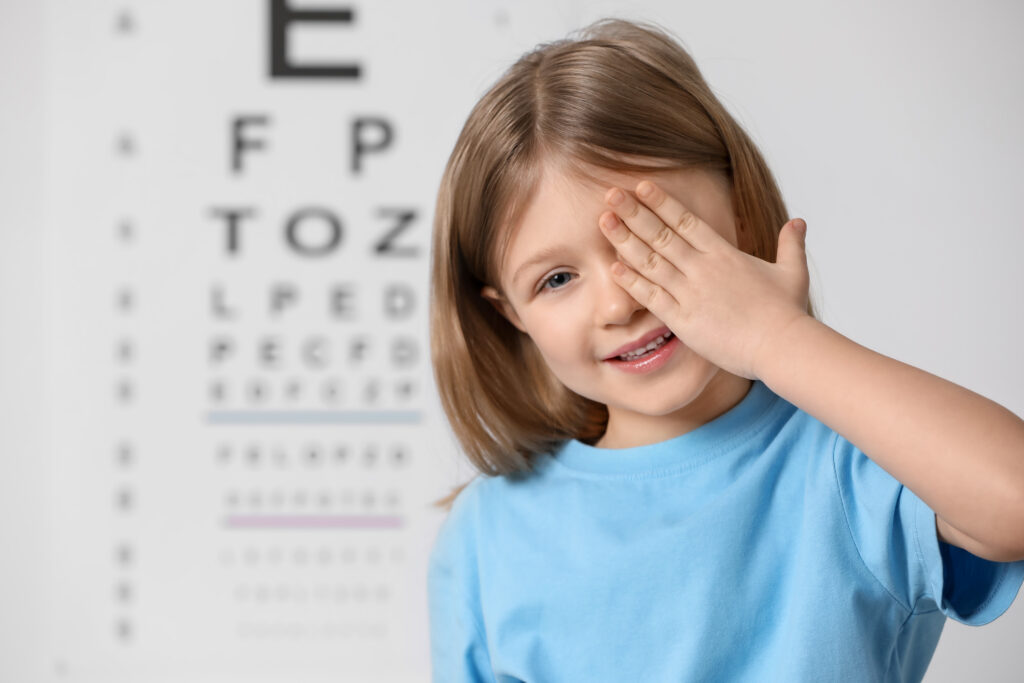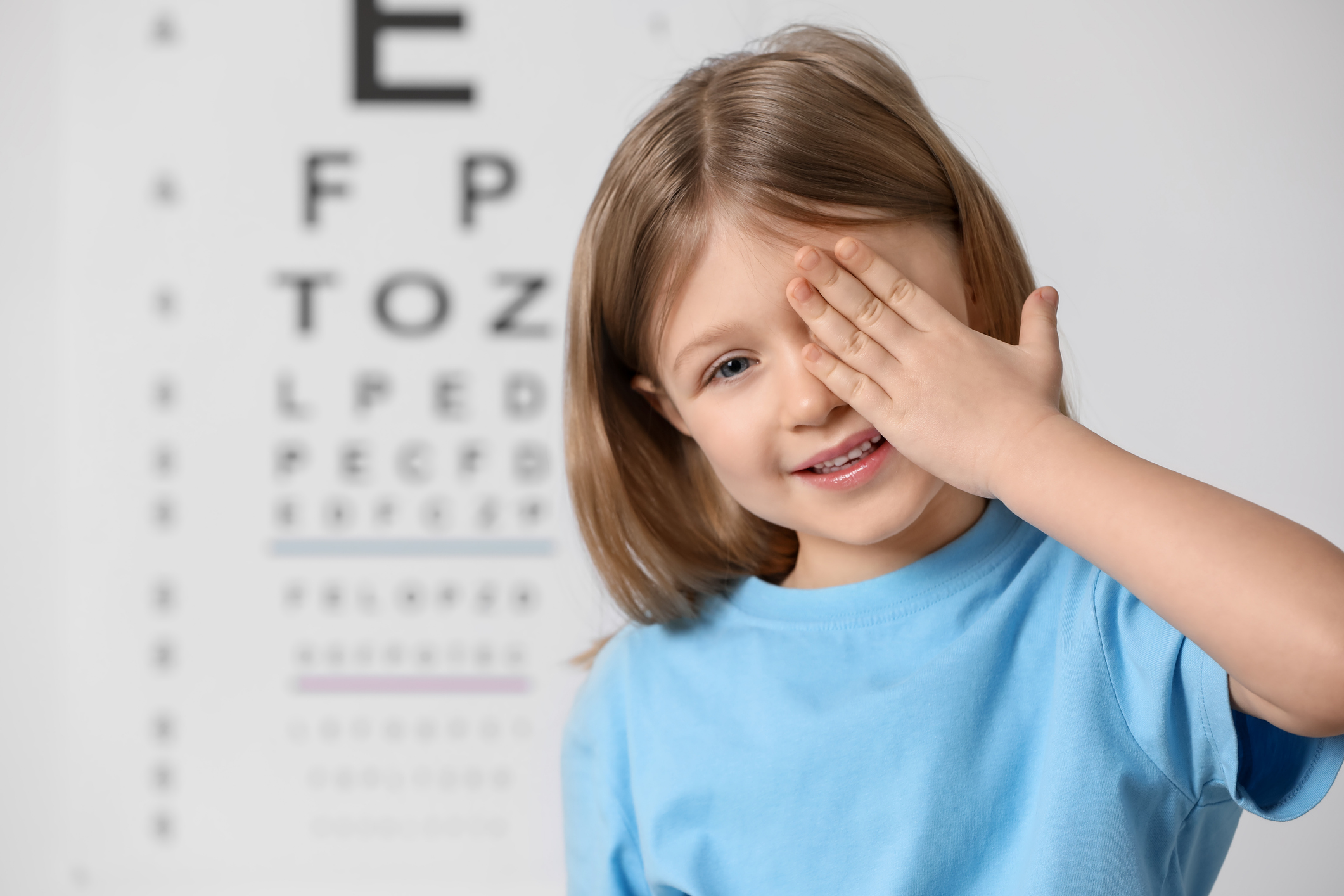
Myopia, commonly referred to as nearsightedness, is a vision condition where objects in the distance appear blurry while nearby objects remain in focus. A child with myopia may read a book or use a smartphone with ease but struggle to see the front of the classroom, see across a playground, or recognize people or signs from afar.
Although glasses and contact lenses correct blurry vision, they do not treat the underlying causes of myopia. Understanding why myopia develops and how to manage it is essential for parents looking to support their child’s long-term eye health.1
Symptoms of Myopia
Children with myopia often display certain signs that indicate their vision may be impaired. Common symptoms include:
- Blurred Distance Vision – Objects that are far away appear out of focus, while nearby objects remain sharp.
- Squinting – A child may squint to temporarily improve their focus when looking at distant objects, such as across a room.
- Sitting Too Close to Screens or Books – A tendency to sit very close to the television or hold books too near the face can indicate difficulty seeing at a normal distance.
- Difficulty Seeing the Board at School – A child may struggle to read words written on a whiteboard, blackboard [TG1] [JS2] or smartboard and may complain of not being able to see clearly
- Frequent Eye Rubbing or Headaches – Eye strain caused by constant squinting can lead to headaches or frequent eye rubbing.
- Avoiding Outdoor Activities – Children with myopia may prefer close-up activities, such as reading or using digital devices, over playing outside, where distance vision is more necessary.
Early detection of these symptoms can help parents seek timely intervention to slow myopia progression.
What Causes Myopia?
Myopia develops when the shape of the eye causes light to focus incorrectly. Ideally, light should land precisely on the retina, the light-sensitive layer at the back of the eye. However, in myopic individuals, the eyeball is too long, or the cornea is too curved, causing light to focus in front of the retina rather than on it. This results in blurry vision for distant objects.
A useful analogy is to think of a camera that is out of focus. If the camera lens is adjusted incorrectly, distant images appear blurry, much like how far away or distance vision becomes blurred in myopia.
Why is Myopia Becoming More Common?
Myopia is becoming increasingly common around the world including here in Canada, with rising screen use and the COVID-19 pandemic playing significant roles in this trend. The increased reliance on digital devices for school, work, and entertainment has led to longer time spent on near-work, and viewing things closer to the eyes, both of which are known risk factors for myopia.2 Children, in particular, have spent more time indoors engaging in screen-based activities, which limits their exposure to natural daylight—an essential factor in normal childhood eye and vision development.
The COVID-19 pandemic further accelerated these changes, as lockdowns and online learning meant that children had fewer opportunities for outdoor play and spent more time on screens for education and leisure. Studies conducted during and since the pandemic have reported a spike in myopia prevalence and faster progression rates, highlighting the impact of these environmental shifts.3,4 As screen use remains a dominant part of daily life, promoting balanced screen time, regular outdoor activity, and good visual habits is essential in addressing the growing myopia epidemic.
You can read more about close work habits and myopia in the article All about screen time and close work on MyKidsVision.org.
The Link Between Myopia and Eye Diseases
Severe or high myopia increases the likelihood of certain eye diseases, which can emerge in early or later adulthood. These include the following.
Retinal Detachment
A myopic eye is elongated or stretched, which causes the retina to thin. This thinning makes the retina more susceptible to tears or detachment, a condition that can lead to severe vision loss if not treated promptly.1
Myopic Macular Degeneration (MMD)
With high myopia, the macula—the part of the retina responsible for detailed vision—can stretch and develop tears or lesions. Over time, this can result in blurry central vision or permanent vision impairment.1
Glaucoma
Glaucoma occurs when increased pressure in the eye damages the optic nerve at the back of the eye, leading to gradual vision loss. Myopic eyes are more prone to structural changes that may contribute to an increased risk of glaucoma.1
Cataracts
Cataracts develop within the eye’s focussing lens, creating cloudy patches that obstruct vision. Although cataracts are more common in elderly adults, people with high myopia may develop them earlier in life.1 You can learn more by reading the article What is myopia control and why it’s important on MyKidsVision.org.
Factors That Influence Myopia Development
Myopia can develop at any stage of life, but it is most frequently diagnosed in children and adolescents, after which it tends to worsen every few to several months before typically stabilizing in the late teenage years or early 20’s. Several factors contribute to its onset and progression.
1. Increased Near Work
Spending extended time on activities that require close focus, such as reading, drawing, or using digital screens, has been linked to myopia.5 The widespread use of tablets and smartphones at a young age may contribute to the increasing rates of myopia worldwide.
2. Genetic Factors
Children with one myopic parent are three times more likely to develop myopia, while those with two myopic parents have a sixfold risk. Myopia can run in families and may be influenced by both genetic and environmental factors.6
3. Under- or Over-Corrected Vision
Not wearing the correct prescription glasses or delaying the use of vision correction can contribute to myopia progression. Regular eye check-ups are essential to ensure that children have the correct lenses to prevent unnecessary eye strain.7
4. Limited Outdoor Time
Research suggests that children who spend more time outdoors have a lower risk of developing myopia. Exposure to bright natural light and the ability to focus on distant objects appear to help regulate healthy eye growth.8,9
How Parents Can Help Manage Myopia
While myopia cannot be reversed, parents can take steps to slow its progression and support their child’s eye vision and eye health.
- Encourage Outdoor Play: Aim for at least two hours of outdoor activity daily to support healthy eye development.8
- Limit Screen Time and Close Work: Encourage regular breaks from screens and reading to reduce prolonged near focus. You can read about regulating screen distance in the article Why the iPhone and iPad ‘Screen Distance’ setting should be enabled for children on MyKidsVision.org.
- Follow the 20-20-20 Rule: Every 20 minutes, encourage children to look at something 20 feet away for at least 20 seconds to relax their eyes.
- Maintain a Healthy Diet: Diets high in saturated fats and cholesterol have been linked to myopia. A well-balanced diet that avoids excessive processed foods and supports overall health may be beneficial for children’s eye development.10,11
- Ensure Adequate Sleep: Getting enough sleep may help reduce the risk of myopia in children. Research suggests that kids who sleep fewer than five hours a night have a higher chance of developing myopia compared to those who sleep nine or more hours.12 Ensuring your child gets enough rest is an easy way to support their overall eye health.
- Schedule Routine Eye Exams: Early detection and management with your child’s Optometrist ensures appropriate vision correction and monitoring of myopia progression.
- Consider Myopia Control Options: Consult your Optometrist about treatments such as special spectacles, contact lenses or atropine eye drops, which can help slow myopia progression.
Next steps to take
Myopia is becoming more common among children worldwide including here in Canada, and early onset in childhood can result in more significant vision challenges in adulthood. Recognizing the symptoms early and understanding the factors that contribute to myopia development can help parents take proactive steps. Encouraging outdoor activities, limiting screen time, and ensuring regular eye exams with an Optometrist are key strategies in managing and slowing the progression of myopia.
References:
- Bullimore MA, Ritchey ER, Shah S, Leveziel N, Bourne RRA, Flitcroft DI. The Risks and Benefits of Myopia Control. Ophthalmology. 2021 Nov;128(11):1561-1579.
- Foreman J, Salim AT, Praveen A, Fonseka D, Ting DSW, Guang He M, Bourne RRA, Crowston J, Wong TY, Dirani M. Association between digital smart device use and myopia: a systematic review and meta-analysis. Lancet Digit Health. 2021 Dec;3(12):e806-e818.
- Gökgöz Özışık G, Yilmaz H. Myopia Progression in School-Age Children During the COVID-19 Pandemic. J Clin Med. 2024 Nov 14;13(22):6849.
- Mu J, Zhong H, Jiang M, Yang W. Epidemiological characteristics of myopia among school-age children before, during, and after the COVID-19 pandemic: a cohort study in Shenzhen, China. Front Med (Lausanne). 2024 Aug 30;11:1368219.
- Morgan IG, Wu PC, Ostrin LA, Tideman JWL, Yam JC, Lan W, Baraas RC, He X, Sankaridurg P, Saw SM, French AN, Rose KA, Guggenheim JA. IMI Risk Factors for Myopia. Invest Ophthalmol Vis Sci. 2021 Apr 28;62(5):3.
- Wang YY, Chen LJ, Tham CC, Yam JC, Pang CP. Genes for childhood myopia. Asia Pac J Ophthalmol (Phila). 2025 Jan-Feb;14(1):100139.
- Tang SM, Zhang XJ, Wang YM, Zhang Y, Wong LM, Chan HN, Zhang BN, Chu WK, Kam KW, Young AL, Tham CC, Chen LJ, French AN, Rose KA, Pang CP, Yam JC. Effect of Myopic Undercorrection on Habitual Reading Distance in Schoolchildren: The Hong Kong Children Eye Study. Ophthalmol Ther. 2023 Apr;12(2):925-938.
- Xiong S, Sankaridurg P, Naduvilath T, Zang J, Zou H, Zhu J, Lv M, He X, Xu X. Time spent in outdoor activities in relation to myopia prevention and control: a meta-analysis and systematic review. Acta Ophthalmol. 2017 Sep;95(6):551-566
- Yu Y, Chen H, Zhang Z, Ye Y, Shen Y, Xu Y, Zheng K, Wang X, Jia Y, Zhou X, Zhao J. Risk factors for rapid axial length growth in a prospective cohort study of 3-year to 9-year-old Chinese children. Br J Ophthalmol. 2025 Jan 31:bjo-2024-326261.
- Gifford KL, Richdale K, Kang P, Aller TA, Lam CS, Liu YM, Michaud L, Mulder J, Orr JB, Rose KA, Saunders KJ, Seidel D, Tideman JWL, Sankaridurg P. IMI – Clinical Management Guidelines Report. Invest Ophthalmol Vis Sci. 2019 Feb 28;60(3):M184-M203.
- Berticat C, Mamouni S, Ciais A, Villain M, Raymond M, Daien V. Probability of myopia in children with high refined carbohydrates consumption in France. BMC Ophthalmol. 2020 Aug 18;20(1):337.
- Chawla O, Singh A, Kumawat D, Chowdhury N, Kumar B. Systematic Review of Sleep Duration and Development of Myopia. Cureus. 2024 Mar 15;16(3):e56216.



